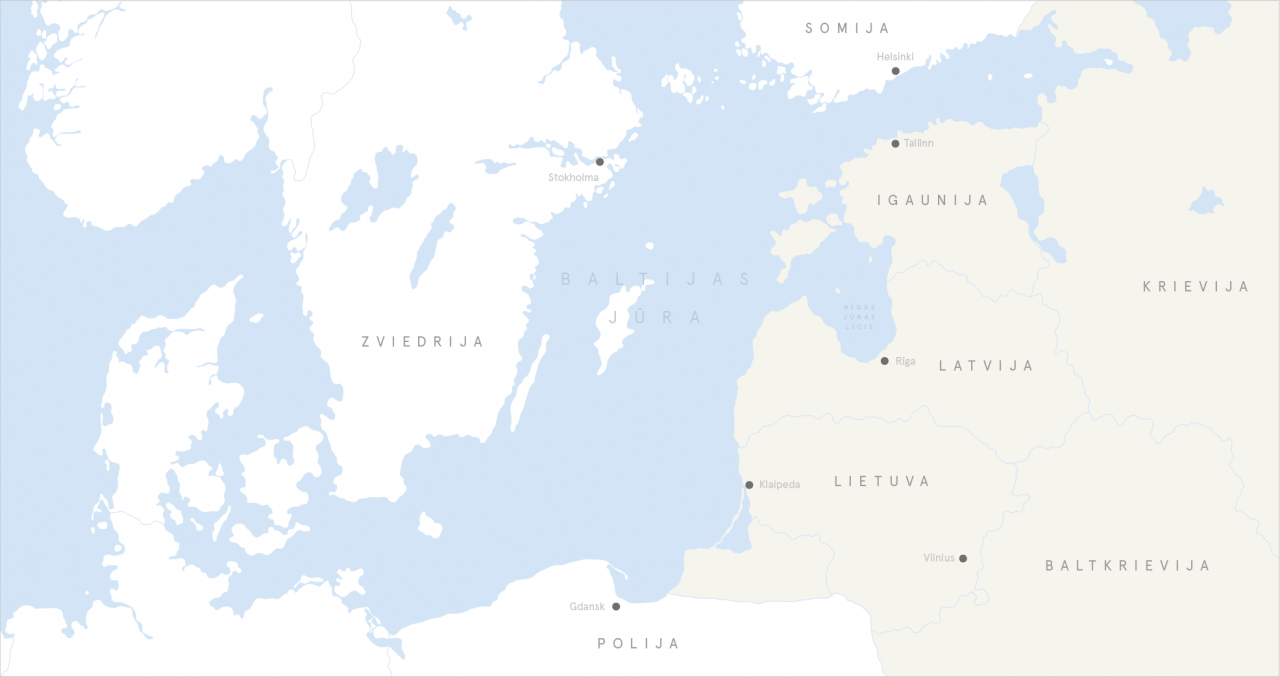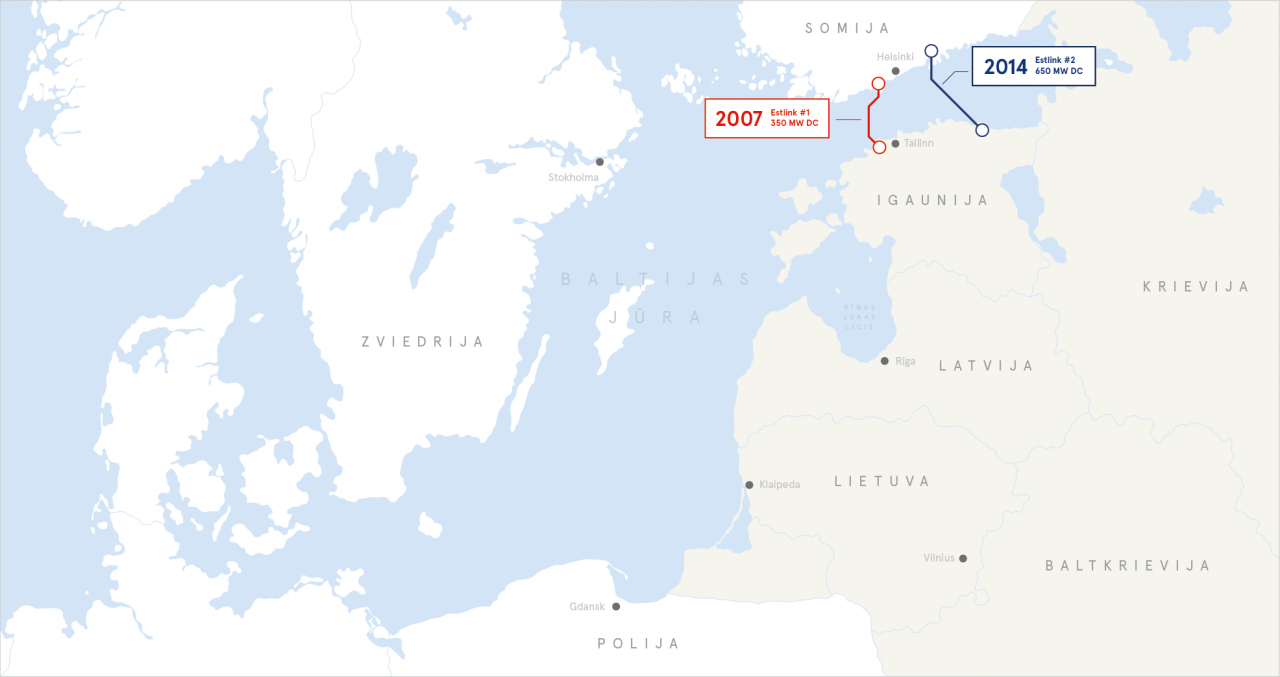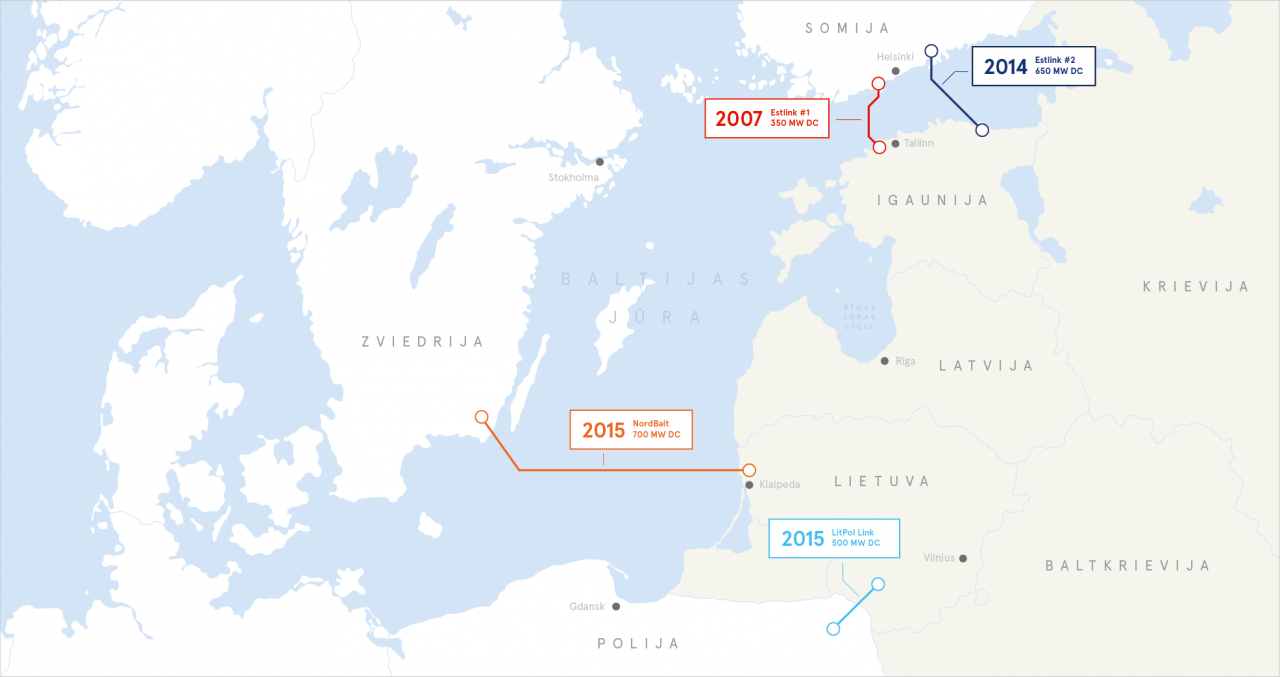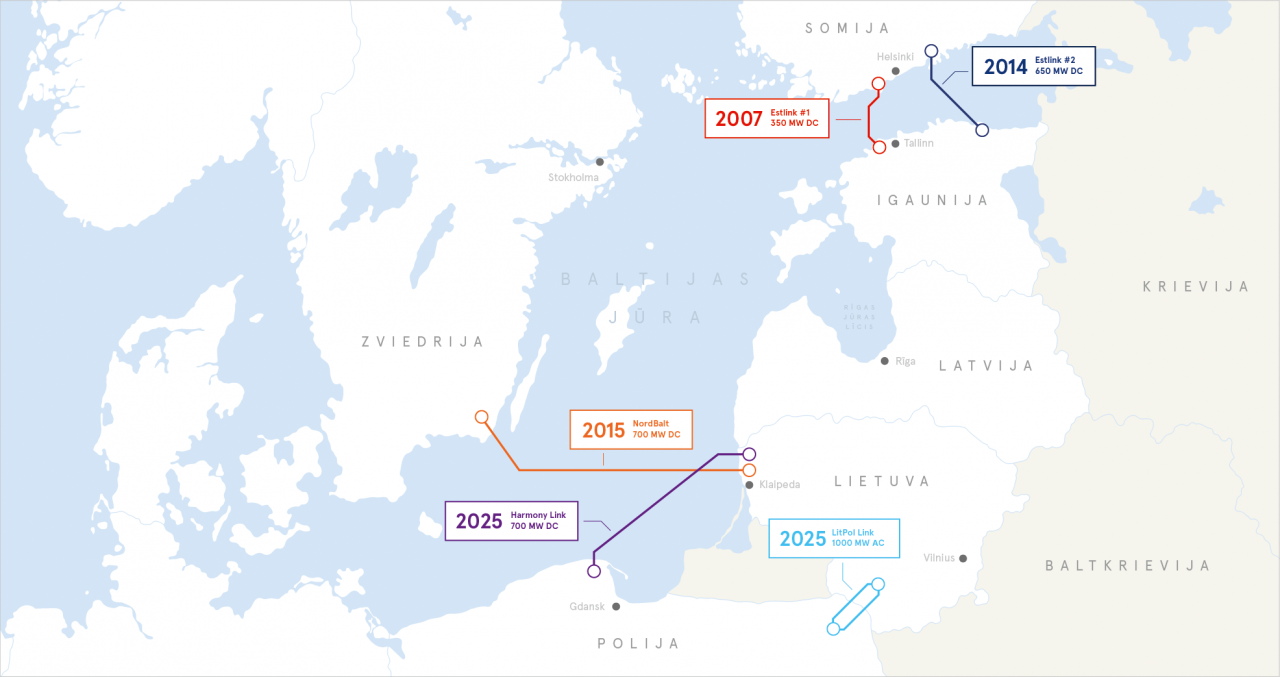The Baltic states have historically operated in synch with the electric power systems of Russia and Belarus. The origins of the idea to synchronise with the European grid go back as far as 2007, when the prime ministers of the Baltic states proposed the idea of investigating this possibility. The synchronisation of the Baltics with the European electric power networks is planned for 2025.
Main benefits

Security: synchronisation will result in the Baltic electric power transmission system becoming part of the European system, meaning more independence from Russia and a more reliable electric power supply.

Price levelling: as a result of synchronisation, Latvia will join the EU market, which will make it possible to level electricity prices throughout the region.

Traders and producers of electric power will be able to sell electric power everywhere in Continental Europe. Studies by European group operators show that the cost of electric power in the Nordic Countries is to decrease over the next decade, resulting in a benefit for the Latvian consumer.
The origins of the idea to synchronise with the European grid go back as far as 2007, when the prime ministers of the Baltic states proposed the idea of investigating this possibility. The synchronisation of the Baltics with the European electric power networks is planned for 2025.
| Communique between prime ministers of the Baltic states |
2007 |
|||||||||||||
2013 |
Synchronisation feasibility study | |||||||||||||
2015 |
||||||||||||||
2015 |
Negotiations with Poland’s TSO and EC have begun |
|||||||||||||
2017 |
||||||||||||||
|
|
2017 |
Isolated operation testing study of the Baltic states’ electric power system | ||||||||||||
2018 |
||||||||||||||
2018 |
Frequency stability study | |||||||||||||
| On 14.09.2018, a political decision regarding the further progress of the synchronisation process in accordance with the solution recommended in studies was adopted by the high-level work group of the Baltic Energy Market Interconnection Plan (BEMIP) member states |
2018 |
|||||||||||||
2018 |
An application for expansion of the synchronous zone was submitted to ENTSO-E in September | |||||||||||||
2019 |
||||||||||||||
2019 |
||||||||||||||
| EU granted the largest possible funding 75% or € 719.7 million to the key second phase projects of the Baltic States‘ synchronisation programme testing |
2020 |
|||||||||||||
Until 2025 |
Strengthening of the Baltic electric transmission network | |||||||||||||
| Synchronisation of the Baltic states with Continental Europe and their de-synchronisation from BRELL |
2025 |
|||||||||||||
Projects to be implemented before the synchronisation of the Baltics with the European electric power networks
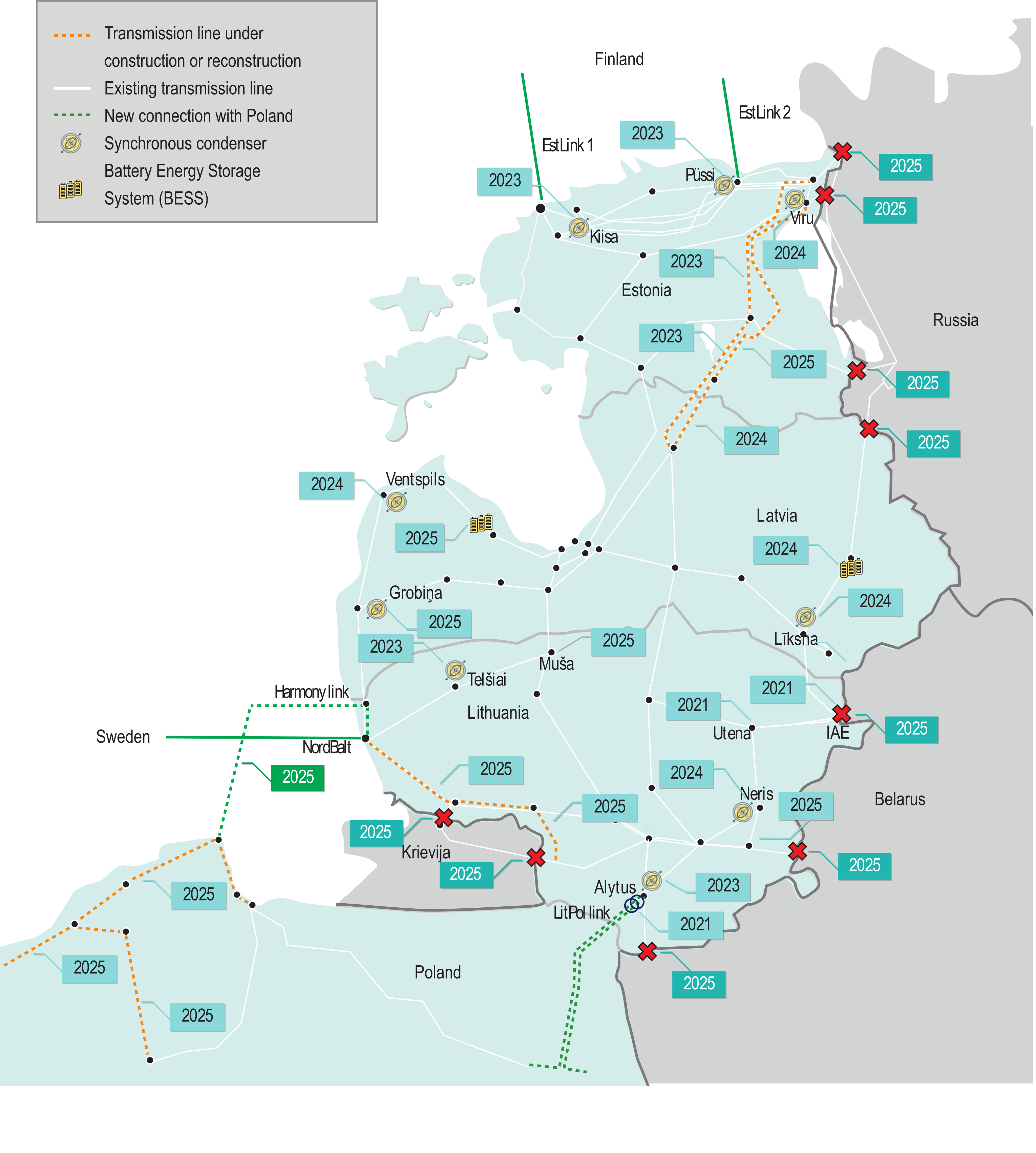
Why is synchronisation necessary?
What is synchronous operation and synchronisation of electric power networks with Europe?
When will synchronisation take place?
What will synchronisation cost?
What projects must be implemented in Latvia?
Why is synchronisation necessary?
The Baltic states have historically operated in synch with the electric power systems of Russia and Belarus. The goal of synchronisation is to make the electric power systems of the Baltics synchronous with Europe, thus reducing dependence on decisions made outside the EU. Synchronisation will expand the ability of the Baltic states to independently manage their electric power systems, striking a balance between production and consumption, managing the necessary reliability reserves, and controlling electric power flows and frequencies without interventions by countries from outside the European Union. The most important benefit will be that of security: synchronisation will result in the Baltic electric power transmission system becoming part of the European system, meaning more independence from Russia and a more reliable electric power supply.
What is synchronous operation and synchronisation of electric power networks with Europe?
Synchronous operation of multiple electric systems means that they are connected to each other via direct-current lines, the systems work at the same frequency, and the electric power flows between the systems depend on the supply and consumption in each of the systems. Thus, the flows can be regulated only partially by changing the production output and consumption amounts in each of the systems.
The main advantage of synchronous work is that if a change occurs in the production or consumption of electric power, it can be compensated within a few milliseconds, based on the laws of physics. This is particularly important for ensuring an uninterrupted supply of consumers in situations when a major producer stops working due to an emergency, or if major consumers, or entire regions are disconnected from the network. The more systems work synchronously, and the larger these systems are, the easier it is to maintain stable operation of the overall synchronised system.
When will synchronisation take place?
The transmission system operators of the Baltic states set 2025 as the target for beginning synchronous operations with Europe and disconnecting from the electric power systems of Russia and Belarus. Until then, it is necessary to make major investments in the construction of new interconnections and rebuilding of current ones, as well as reinforcing of the current networks and network management and control systems in each separate country.
What will synchronisation cost?
The long-term costs of synchronisation will be less than the infrastructural investments that the Baltic states would have to make if they were to remain in sync with Russia and Belarus. All the development projects pertaining to synchronisation are provided with EU co-financing, with addition of the income that the transmission operators get from overload management, resulting from differences in the price of electric power in different trading areas. The operating costs of AST may rise to a certain degree, because Poland has demonstrated the impossibility of building a second direct-current interconnection as was initially planned, which is why there will only be one direct-current sea cable between Lithuania and Poland. This fact and the resulting rise in the operating costs of the transmission system may somewhat affect the transmission fees.
In March 2019, the transmission system operators of the Baltic states, the Estonian AS Elering, the Latvian AS ‘Augstsprieguma tīkls’ (AST) and the Lithuanian Litgrid AB concluded a grant agreement with the Innovation and Networks Executive Agency (INEA) for receiving 75% co-financing (323 million euros) for the first phase of the Baltic synchronisation project. The total cost for Latvia will be EUR 77 million, of which EUR 57.75 million will be co-financed.
The first phase includes the reconstruction of existing power transmission lines in Lithuania, Estonia and Latvia, construction of new lines, installation of autotransformers at the Alytus substation in Lithuania, as well as the upgrading and installation of power system inertia, frequency adjustment and system control equipment.
What projects must be implemented in Latvia?
At the moment, most of the projects related to synchronisation are being implemented. The construction of ‘The Kurzeme ring’ will end in 2019, while the ‘Estonia-Latvia third interconnection’ project is marked for completion in 2020. The importance of these projects goes beyond synchronisation: ‘The Kurzeme ring’ will improve the reliability of electric power supply in the Kurzeme region, while the construction of the interconnection will make it possible for the residents of Latvia to buy cheaper electric power from Nordic countries.
Construction of the 330 kV power transmission line ‘Power Transmission Line Riga CHP-2 - Riga HPP’ began in 2019. This line is expected to start operation by the end of 2020, because it is an important element in strengthening the Latvian internal network as part of providing full functionality of the new ‘Estonia-Latvia third interconnection’ line in normal mode, and in emergency and repair modes. Latvia still has to rebuild two interconnections between Valmiera and Estonia; attention must be paid to specific problems related to system services, and some new systems must be bought.
A number of studies were carried out from 2013, which reviewed the possible scenarios of synchronising Baltic electric power networks with Europe, the technical requirements of the Baltic states, as well as the synchronisation measures to be implemented. Most of the studies were carried out with the support of EU structural funds, because synchronisation was established as a strategic goal in the European energy policy.
TEPCO study provides recommendations for Baltic States on expansion of renewable energy sources by 2050
As Baltic States prepare to dramatically increase renewable energy production and generate up to 100% electricity from renewable energy sources by 2050, Japanese energy company TEPCO Power Grid Inc. analysed technical measures and economic considerations that need to be tackled. TEPCO’s feasibility study provided recommendations and specified minimum requirements for new converter-based generation in Baltic States. Read more
Research on Additional Measures and Costs that are Required for the Synchronisation of the Baltic States with Continental Europe
After the assessment of dynamic research results and presentation thereof to the European Commission and ministries of the Baltic states responsible for energy, Poland refused to implement the second alternating current link scheduled on their side and stated that Poland is only ready to implement an additional direct current sea cable between Poland and Lithuania. Read more
Dynamic Stability Research
In late 2017, the TSOs of the Baltic states and Poland commenced dynamic stability research to analyse the potential expansion of the continental Europe network with the electricity networks of the Baltic states and effect thereof on the networks of continental Europe. The research was conducted by a consultant from Poland – Gdansk Institute of Power Engineering according to the order of the TSOs of the Baltic states and Poland. Read more
The isolated operation of the Baltic states
The feasibility study on the isolated operation of the Baltic States has been finalised by the end of August 2017. The study has been ordered by Litgrid, AST and Elering, the electricity transmission system operators of respectively Lithuania, Latvia and Estonia, and prepared by the international consulting company Tractebel Engineering S.A. Read more
Integration of the Baltic States into the EU electricity system: A technical and economic analysis
In the spring of 2017 European Join research center has finalised the study “Integration of the Baltic States into the EU electricity system: A technical and economic analysis”. Upon investigating possible technical and economic scenarios on de-synchronizing the networks of Baltic countries from power systems of Russia and Belarus and synchronizing with networks of Europe, has been concluded that from the technical and economic point of view it would be more favorable for Baltic countries to become synchronized with continental Europe, as it has been stated in the study prepared by the European Join Research Centre and published by European Commission. Read more
Synchronous operation study: The Baltic States integration to the EU internal electricity market
The feasibility study on the interconnection variants for the integration of the Baltic States to the EU internal electricity market has been accomplished. The study has been ordered by Litgrid, Augstsprieguma tikls and Elering – electricity transmission system operators of Lithuania, Latvia and Estonia in cooperation with a Swedish consulting company Gothia Power. Read more
Project events
The Latvian transmission system operator JSC "Augstsprieguma tīkls" (AST) signed a contract for the supply and…
The Latvian transmission system operator JSC "Augstsprieguma tikls" (AST) received three tenders in the open tender…


